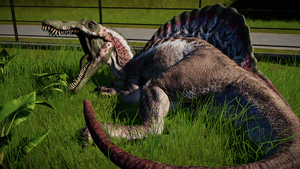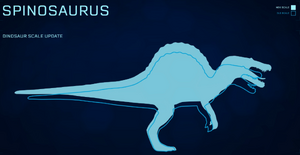Template:Dinosaur Infobox
| I know this dinosaur... it’s a Spinosaurus. So named because of the spines running down its back. Seriously, who needs a PhD for this one? |
Spinosaurus is a large genus of spinosaurid dinosaur that originated in Late Cretaceous Africa. Spinosaurus is first encountered as a wild animal on Isla Sorna, and can subsequently be bred by extracting its DNA from fossils discovered in the Chenini and Bahariya Formations.
It's possible for a Spinosaurus to be fused with a Velociraptor in the Secrets of Dr. Wu DLC pack, creating a Spinoraptor hybrid.
History
After the San Diego Incident in 1997, which brought the existence of dinosaurs on Isla Sorna to public knowledge, the failing InGen, which had all but collapsed in the wake of the disaster, was purchased by Masrani Global.[1] Only one hundred days after the deal was finalized, and in violation of the Gene Guard Act, which banned access to Isla Sorna and the cloning of prehistoric species, an InGen team incubated several new species of dinosaur, including Ankylosaurus, Ceratosaurus, Corythosaurus, and most notably, Spinosaurus.[1]
Bred covertly in 1999 under hybrid "Amalgam Testing", which paved the way for genetically modified creations such as the Indominus rex, the Spinosaurus was experimented on over a period of nine months before being abandoned on the island.[1][2]
A Spinosaurus faces off against a Tyrannosaurus.
In 2001, the only Spinosaurus known to have been cloned by InGen was encountered on numerous occasions by the survivors of a plane crash on Isla Sorna and was responsible for the deaths of numerous individuals, as well as a Tyrannosaurus which had entered its territory.[3] Reports of the Spinosaurus was later reported to the authorities by the survivors, but it was covered up by "bribed officials" and went undisclosed until 2015.[1]
The introduction of the Spinosaurus, and to a lesser extent the other illegal species, had a profound impact on the ecosystem of Isla Sorna, resulting in a considerable population drop which mystified the scientific community until 2015. In 2004, the surviving dinosaurs on Sorna were transported to Jurassic World on Isla Nublar, though it remains unconfirmed if the Spinosaurus was among them.[1] Regardless, in 2018, the animal was reported as extinct.[4]
Description
Heavily built and fearsome, the base genome of the Spinosaurus is primarily grey with distinctive patterns of red across the body, and blue circular patterns across its impressive sail. As a large and territorial predator, in fact one of the park's largest predatory dinosaurs, Spinosaurus has been known to challenge similarly sized carnivores such as Tyrannosaurus, and can effortlessly lift a hadrosaur, such as Maiasaura, off its feet with its jaws and slam it into the ground.[5]
More tolerant of its own kind than Tyrannosaurus or the two hybrid predators, Spinosaurus can be housed safely in pairs barring occasional stand offs.
Paleontology
Spinosaurus remains have been found in Egypt, Tunisia, and Morocco. The first remains were found in Egypt by a German palaeontological team led by Ernst Stromer in 1915 and brought to a museum in Munich. Other fossils found were those of a small sauropod Aegyptosaurus, a myriad of crocodiles and fish and another massive carnivorous theropod, the fearsome Carcharodontosaurus. Unfortunately, these fossils were destroyed during a bombing raid in World War II. Since then, Spinosaurus was referenced in books as a moderately sized dinosaur with a sail and posture of a generic theropod, but was overshadowed by the likes of Allosaurus and Tyrannosaurus.
In the 1990s, with new discoveries in Tunisia and Morocco, it was revealed not only the crocodile-like snout shared by all known spinosaurids, but the sheer size of the animal, among the largest theropods ever found. From the 1990s to the early 2010s, Spinosaurus was shown as a massive bipedal super predator, hunting anything it wished and challenging other large carnivorous theropods. However, subsequent discoveries overshadowed this depiction of the animal, and Spinosaurus was reconstructed as a quadrupedal fish eater, which could occasionally rear on its hind legs. While the quadrupedal movement has since been disproven, the narrow jaws weren't suitable for tangling with large prey and so it had to catch fish; however, evidence suggests spinosaurids did hunt terrestrial prey as well.
The sail of Spinosaurus has also been a point of discussion, like that of Ouranosaurus from Niger, with some claiming it is a large sail for display or thermoregulation like Dimetrodon, and others arguing it is a fat-filled hump like that of a camel for dry periods.
Trivia
- Spinosaurus was the seventeenth dinosaur to receive a Species Profile.
- The appearance of the Spinosaurus in Jurassic World Evolution is directly based on the animal's depiction in Jurassic Park III, although the colours of its sail are more distinctive.
- Spinosaurus previously appeared in Jurassic Park: Operation Genesis, considered by many to be Jurassic World Evolution's spiritual predecessor.
- According to recent reconstructions, Spinosaurus had a single crest on top of its head, much shorter legs, an M-shaped sail, and was likely semi-aquatic. However, Donald Henderson's study of the Spinosaurus's bones reveals that it is not capable diving underwater and it might still be bipedal like all theropods, but it remains debated.
- The only species of Spinosaurus was S. aegyptiacus. However, a potential second species was uncovered in Morocco in 1996, called S. moroccanus.
- Like the Torosaurus, there is a slight dating error in the InGen file for Spinosaurus where the date of discovery is said to be 1922 instead of 1912.
- Spinosaurus can yield the highest overall rating per enclosure of any large carnivore. While its individual rating might be slightly lower than Tyrannosaurus, Indominus rex, or Indoraptor when maxed out, they can both be housed in pairs and alongside smaller carnivores like Dilophosaurus without much issue. If space is an issue and one wants to maximize potential profit from a limited number of enclosures, a combination of two Spinosaurus and a pack of Dilophosaurus will yield the highest result.
- The Spinosaurus in the game was originally much smaller than the Tyrannosaurus, but thanks to Update 1.4, which shrunk Ceratosaurus and T. rex, as well as increased the size of the Giganotosaurus and the Spinosaurus, the Spinosaurus is now slightly larger than the T. rex.
Gallery
References
- ↑ 1.0 1.1 1.2 1.3 1.4 http://www.dinosaurprotectiongroup.com/what-killed-the-gene-guard-act.html Dinosaur Protection Group - What Killed the Gene Guard Act
- ↑ Masrani Backdoor
- ↑ Jurassic Park III
- ↑ Dinosaur Protection Group - Poster "Cruelty", available (http://www.dinosaurprotectiongroup.com/)
- ↑ Species Profile - Spinosaurus, https://www.youtube.com/watch?v=VpUUpKPkpE0
Further reading
Template:JWEDinosaurs
External links
Spinosaurus on Wikipedia















